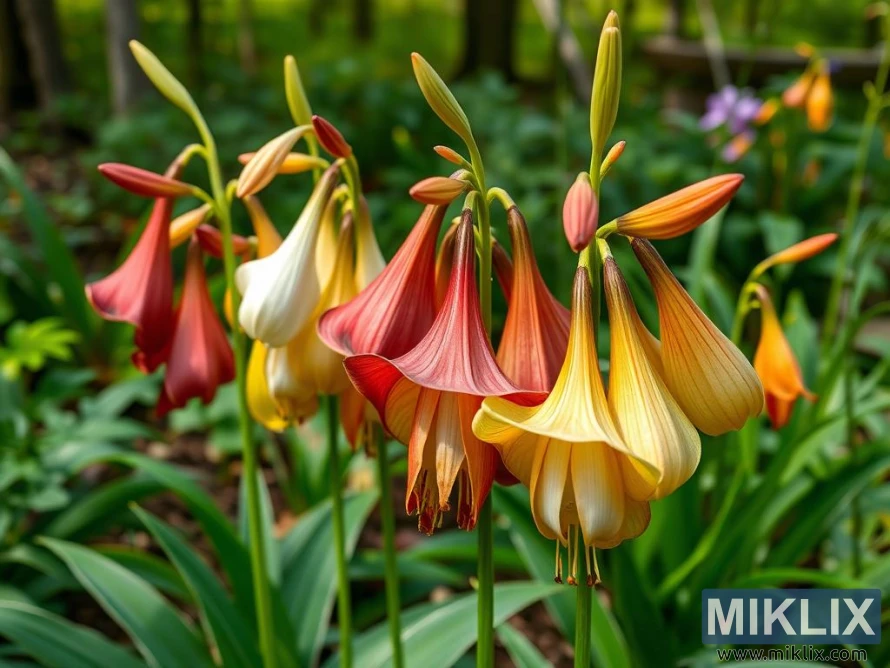Image: Graceful Bell-Shaped Lilies in Bloom
Published: August 22, 2025 at 9:02:32 AM UTC
Last updated: September 27, 2025 at 11:27:21 PM UTC
Elegant bell-shaped lilies in yellow, orange, and red hang gracefully from tall stems amid lush green foliage in a tranquil garden.
In this woodland garden scene, the lilies present themselves like living lanterns, suspended gracefully on tall, slender stems that sway lightly with the breeze. Each bloom carries a sense of quiet elegance, their petals curving downward in a manner that both conceals and reveals, creating a natural sense of mystery. The bell-shaped flowers display a remarkable gradient of warm tones, beginning with pale golden yellows that deepen into richer hues of amber and orange, eventually melting into burnt reds and soft crimson. This seamless transition of color across the petals produces an effect reminiscent of the shifting light of dawn or dusk, as though each blossom were infused with the glow of the sun at different times of day.
The orientation of the flowers, facing downward with their tips gently arched, evokes the shape of hand-crafted lanterns or bells frozen in mid-sway. This form lends them a rare delicacy, as though they were designed for illumination rather than display. The soft sheen on the petals catches the sunlight as it filters through the canopy above, creating highlights and shadows that emphasize the subtle texture of each bloom. In the dappled woodland light, they seem to glow from within, their colors intensified against the green tapestry of leaves below.
The surrounding foliage provides a lush and grounding backdrop for this vibrant cluster. Long, narrow leaves spread outward in sweeping arcs, their deep green tones complementing the fiery palette of the blossoms. Together, the flowers and foliage create a natural harmony, balancing brightness with depth, movement with stillness. The contrast between the vertical stems and the downward blooms emphasizes the lilies’ unique architecture, each plant a study in graceful balance.
Among the flowers, some blossoms are fully open, revealing the delicate interiors where stamens extend with quiet confidence, their tips carrying faint traces of pollen. Others remain closed, their elongated buds rising upward like promises of beauty yet to come. These unopened forms echo the shapes of the opened bells, creating a rhythm of repetition and anticipation within the cluster. This interplay between maturity and potential lends the scene a dynamic sense of growth and renewal, as though the garden itself is in constant conversation with time.
The woodland setting enhances their allure. Soft shadows from nearby trees fall across the ground, their patterns shifting with the movement of leaves above. The lilies rise proudly amidst this quiet natural stage, their colors burning brightly against the more subdued greens and browns of their environment. The atmosphere is tranquil, yet charged with life, the blossoms radiating not only beauty but also a sense of exotic wonder, as though they belong to a realm just beyond the ordinary.
This cluster of lilies becomes more than a floral display; it is a living embodiment of transition and harmony. Their warm spectrum of colors suggests both fire and light, vitality and calm. The way they lean together, each blossom distinct yet unified with the others, creates a vision of community within nature, a reminder of how diversity in form and hue can combine into something profoundly cohesive. Standing among them, one feels the quiet poetry of the woodland garden—an environment where elegance, resilience, and gentle brilliance coexist in perfect balance.
The image is related to: A Guide to the Most Beautiful Lily Varieties to Grow in Your Garden

